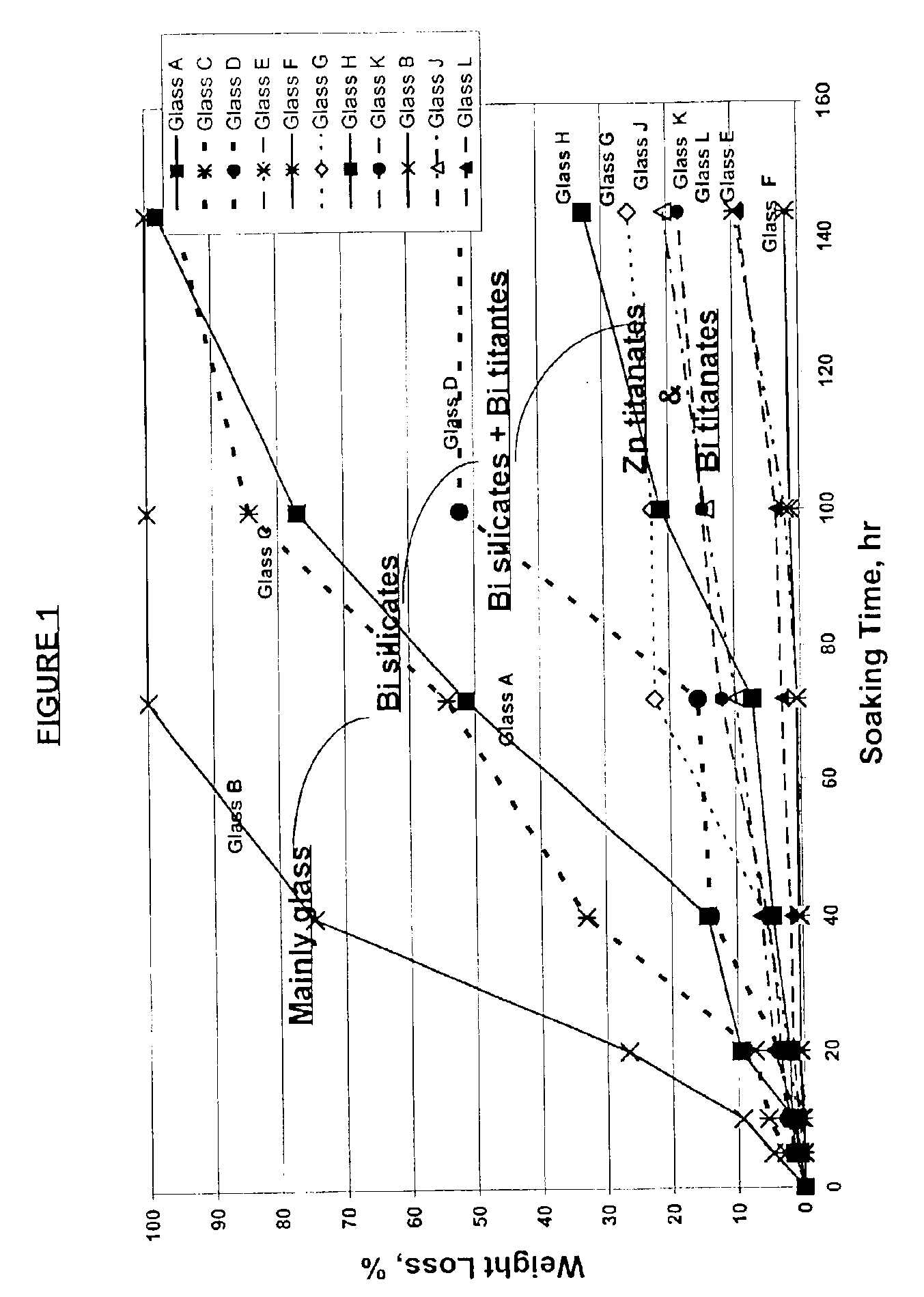Durable glass enamel composition
a technology of glass enamel and composition, applied in the field of glass enamel composition, can solve the problems of less than desired chemical durability of lead-free and cadmium-free glass enamel systems used in automotive glass applications, and achieve the effect of excellent acid resistance and low firing temperatur
- Summary
- Abstract
- Description
- Claims
- Application Information
AI Technical Summary
Benefits of technology
Problems solved by technology
Method used
Image
Examples
example 1
[0034]Glasses A through M were prepared using conventional glass making techniques such that they had the composition by weight percent shown in Table 1 below. Glasses A, B, and C do not precipitate predominantly titanate crystals and thus, when viewed alone, do not provide a glass component within the scope of the present invention. Glasses D through M, when viewed alone, do provide a glass component that is within the scope of the present invention.
[0035]
TABLE 1Constituent (Weight Percent)GlassSiO2TiO2Bi2O3ZnOLi2OK2OB2O3Other OxidesA21.3—70.32.40.51.0—Nb2O5-3.1BaO-1.4B19.0—54.12.11.8——Nb2O5-2.8BaO-2.2MnO2-13.5Cr2O3-4.5C21.52.470.82.40.51.0—BaO-1.4D21.04.669.22.30.51.0—BaO-1.4E28.212.148.4—1.64.94.8—F20.220.148.4—1.64.94.8—G15.98.462.85.11.13.43.3—H16.88.966.5—0.63.63.6—J32.123.38.824.21.44.45.8—K28.319.823.118.21.24.25.2—L14.67.757.5—0.63.13.0Cr2O3-13.5M16.08.563.3—0.63.43.4CuO-4.8
example 2
[0036]Glasses A through M from Example 1 were each milled to an average particle size of from about 2 to about 6 microns and then dispersed in C31 medium (available from Ferro Corporation of Cleveland, Ohio) and mixed in a high shear mixer for about 10 minutes. The weight ratio of the solids to medium was about 7.5. The resulting pastes were each screen printed onto 5 cm by 10 cm by 3 mm thick automobile windshield coupons (on the tin side) using a 160 mesh screen to a wet print thickness of about 1 to about 1.5 mils. The glass coatings were dried in a forced air oven at about 185° F. for about 30 minutes and then heat treated in an oven held at about 1250° F. for about 5 minutes. After cooling to room temperature (about 25° C.), X-ray diffraction patterns of the fired glass coating were taken using Cu K-alpha radiation to determine the type of crystalline materials, if any, precipitated in the glass coating during the 1250° F. heat treatment.
[0037]The results are reported in Table ...
example 3
[0039]Glass Enamel Compositions 1 through 5 were each formed by combining the constituents in the parts by weight shown in Table 3 below. Glasses B, H, K, L, and M were from Example 1. O-1749B Pigment is a copper manganese iron inorganic pigment, K751 Pigment is a copper chrome manganese inorganic pigment, and V792 Pigment is a nickel chrome manganese iron inorganic pigment, and C31 is an auto glass enamel medium, each of which is available from the Ferro Corporation of Cleveland, Ohio.
[0040]
TABLE 3EnamelEnamelEnamelEnamelEnamelConstituent12345O-1749B Pigment17.5———17.5K751 Pigment—555—V792 Pigment—12.512.512.5—Glass B40401040—Glass H————80Glass K40————Glass L—4070——Glass M———40—C31 Medium17.417.417.417.417.4
PUM
| Property | Measurement | Unit |
|---|---|---|
| temperature | aaaaa | aaaaa |
| width | aaaaa | aaaaa |
| temperature | aaaaa | aaaaa |
Abstract
Description
Claims
Application Information
 Login to View More
Login to View More - R&D
- Intellectual Property
- Life Sciences
- Materials
- Tech Scout
- Unparalleled Data Quality
- Higher Quality Content
- 60% Fewer Hallucinations
Browse by: Latest US Patents, China's latest patents, Technical Efficacy Thesaurus, Application Domain, Technology Topic, Popular Technical Reports.
© 2025 PatSnap. All rights reserved.Legal|Privacy policy|Modern Slavery Act Transparency Statement|Sitemap|About US| Contact US: help@patsnap.com

